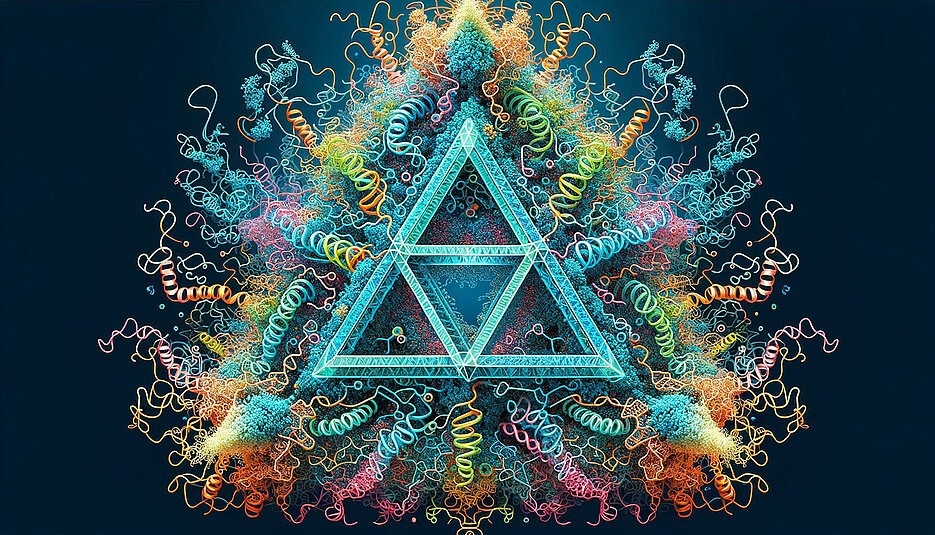Reviewed by Danielle Ellis, B.Sc.Dec 4 2023
Cutting-edge super-resolution microscopy techniques can now achieve optical resolutions within the range of a few nm, corresponding to the size of cellular molecules.
 PicoRuler. Protein-based molecular rulers make it possible to test the optical resolution of the latest super-resolution microscopy methods on biomolecules in the sub-10-nanometre range under realistic conditions. Image Credit: Gerti Beliu, DALL-E 3/University of Würzburg.
PicoRuler. Protein-based molecular rulers make it possible to test the optical resolution of the latest super-resolution microscopy methods on biomolecules in the sub-10-nanometre range under realistic conditions. Image Credit: Gerti Beliu, DALL-E 3/University of Würzburg.
However, assessing the achieved resolution on cellular building blocks, such as multiprotein complexes, has been challenging due to the lack of biomolecular reference systems labeled with dyes at precisely defined positions within a few nanometres.
Addressing this limitation, a team led by Dr Gerti Beliu and Professor Markus Sauer from the Rudolf Virchow Centre at Julius-Maximilians-Universität (JMU) Würzburg in Bavaria, Germany, has introduced a groundbreaking development.
Published in the journal Advanced Materials, their work introduces novel biocompatible molecular rulers known as PicoRulers (Protein-based Imaging Calibration Optical Rulers).
Through the application of genetic code expansion and click chemistry, the team successfully engineered these custom molecular rulers. These PicoRulers serve as accurate biomolecular reference structures in fluorescence microscopy, marking a significant advancement in the field.
Technological Masterpiece: Precision at Molecular Level
Derived from the three-part protein PCNA (Proliferating Cell Nuclear Antigen), the PicoRulers are intricately linked to the fundamental processes of DNA replication and repair.
By strategically incorporating unnatural amino acids at defined positions, the protein has undergone targeted modifications, facilitating the specific attachment of fluorescent dyes or other molecules with minimal linkage errors.
This tailored molecular design allows researchers to assess the resolution of cutting-edge super-resolution microscopy methods with unparalleled precision, focusing on precisely defined cellular biomolecules.
The ability to resolve real biological structures at sub-10-nm level marks a new era in biological imaging. Compared to previously used artificial macromolecules, our PicoRulers are not only characterized by their biological compatibility. They also enable unrivaled precision for testing resolution under realistic conditions.”
Markus Sauer, Professor, Rudolf Virchow Center, Center for Integrative and Translational Bioimaging, Julius-Maximilians-Universität Würzburg
Opening the Door to Investigate Complex Processes in Cells
This technology transcends the conventional limits of microscopy, reaching into broader applications.
Our PicoRulers are not only a tool for more precise measurements, but also open the door to a deeper and more detailed investigation of complex processes that take place within our cells.”
Dr Gerti Beliu, Rudolf Virchow Center, University of Wuerzburg
Strong Potential for Future Applications
The ongoing advancement of PicoRulers holds the potential to revolutionize biological and medical imaging with molecular precision over the long haul.
For the first time, they enable the validation and enhancement of the resolution capabilities of emerging super-resolution microscopy techniques when applied to biological samples. This positions them as a valuable instrument for future endeavors in unraveling the molecular organization and interactions of biomolecules within cells.
Source:
Journal reference:
Helmerich, D. A., et al. (2023) Pcna as Protein-Based Nanoruler for Sub-10 Nm Fluorescence Imaging. Advanced Materials. doi.org/10.1002/adma.202310104.